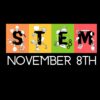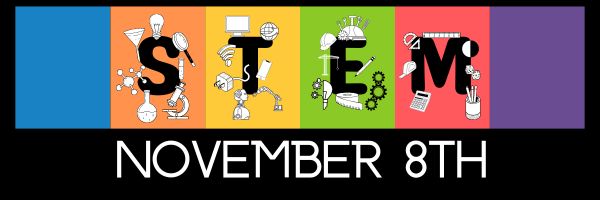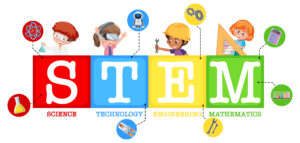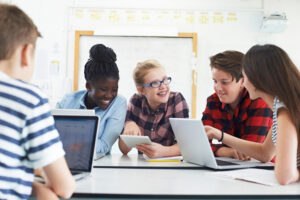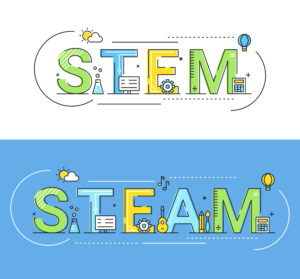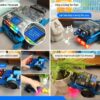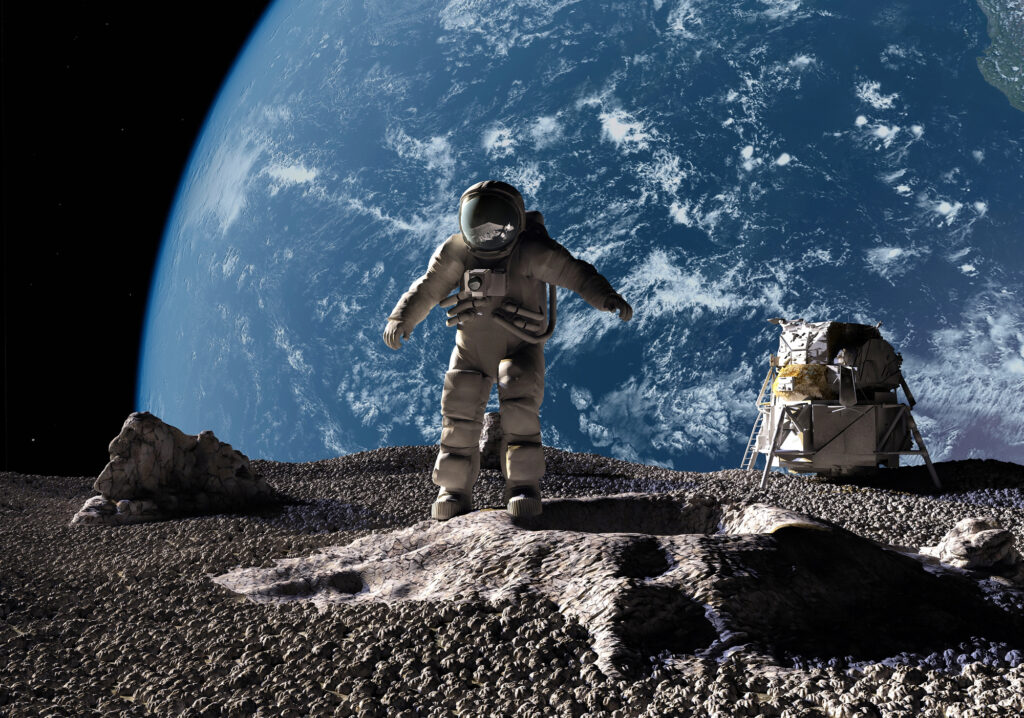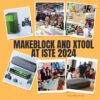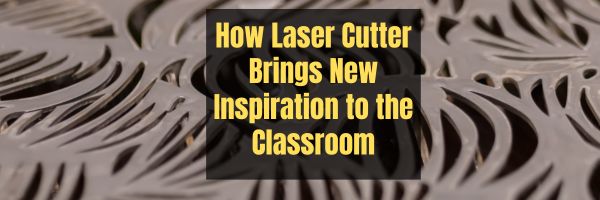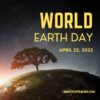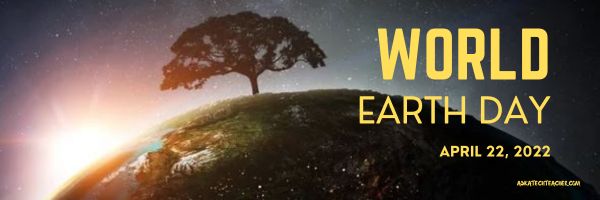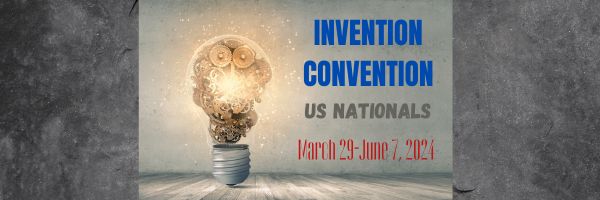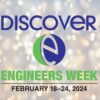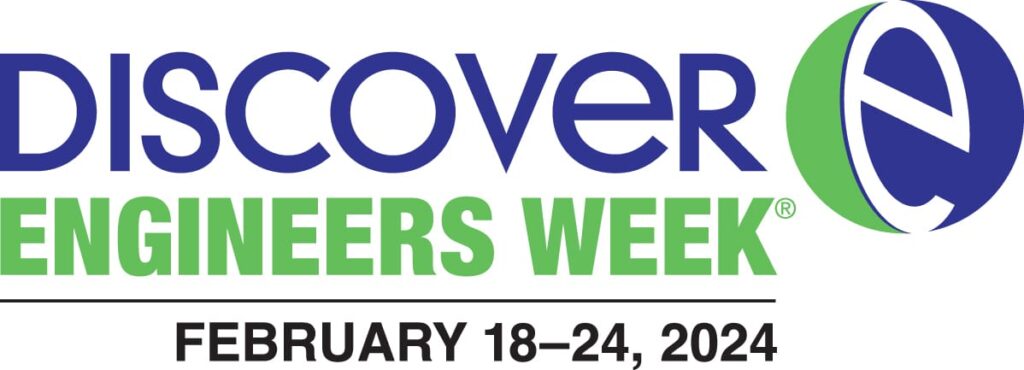Category: Science
National STEM Day Nov. 8th
National STEM Day is November 8, 2024, the unofficial holiday that celebrates science, technology, engineering and mathematics (STEM) education throughout the United States. Many add ‘art’ to the celebration for the acronym, STEAM. Here are some great ideas that remind your students of the excitement that is these core subjects:
Ten Ways to Celebrate National STEM Day with NASA
National STEM Day focuses on helping students advance in STEM fields, a priority of NASA as we continue to push the boundaries of exploration and soar into the future. In celebration of National STEM Day, we challenge you to engage and inspire the Artemis generation as we go forward to the Moon by 2024 and continue to innovate in the areas of Earth science and aeronautics. To help you join in on the festivities, here are 10 ways you can celebrate National STEM Day with us.
49 STEM Activities for Students
On November 8th, we will celebrate National STEM Day to get kids excited about Science, Technology, Engineering, and Math (STEM). Together the STEM subjects represent some of the fastest-growing and most in-demand fields in the United States.
While STEM topics seem a natural fit in high schools and post-secondary curriculum, education experts are promoting a focus on STEM subjects for younger and younger children.
12 Projects for your STEAM program
Twelve favorite STEAM projects where artistic thinking becomes the engine for unpacking solutions.
Activities from Engineering for Kids
National STEM/STEAM Day is dedicated to all things science, technology, engineering, art, and math. STEM (and STEAM) represents some of the fastest-growing and in-demand fields in the world today and Engineering For Kids is passionate about inspiring the next generation of engineers, artists, and innovators.
Bring Weather into Your Lesson Plan with Earth Networks and WeatherSTEM
One of the hottest topics in schools and an area of greatest need is STEM resources. Earth Networks has developed creative and compelling STEM curricula on a variety of weather topics. Any school with a weather unit or an onsite weather station will appreciate this site. I asked them to drop in and explain their education programs to the AATT community:
This STEM bundle includes four lesson plans: Engineering and Design, The Human Body, Keyboarding and the Scientific Method, and Robotics. All incorporate technology into authentic class activities such as bridge building, note-taking, and math. Each lesson plan includes an Essential Question and Big Idea, average time required to complete, suggested appropriate grade level, suggested teacher preparation, step-by-step directions (see preview for an example), assessment strategies, pedagogic background, samples, and images (where relevant).
Share this:
- Click to share on Facebook (Opens in new window) Facebook
- Click to share on X (Opens in new window) X
- Click to share on LinkedIn (Opens in new window) LinkedIn
- Click to share on Pinterest (Opens in new window) Pinterest
- Click to share on Telegram (Opens in new window) Telegram
- Click to email a link to a friend (Opens in new window) Email
- More
Introducing the Makeblock mBot2: A Fun and Educational AI Robot for Coding
Introducing the Makeblock mBot2: A Fun and Educational AI Robot for Coding
The Makeblock mBot2 is a delightful and educational AI robot designed to captivate the interest of children aged 8-12 in the fields of STEM. This robot toy not only provides an engaging visual learning experience but also teaches essential skills in programming, electronics, robotics, and computer science. It is a popular choice for educational settings such as classrooms and after-school programs, as well as for home use, fostering the development of logical thinking, problem-solving, and project creation abilities.
A Beginner-Friendly STEM Kit with Rich Educational Resources
The mBot2 is an ideal starting point for young robotics enthusiasts, offering an easy-to-assemble kit that most children can build in less than 30 minutes. This quick setup allows them to jump right into coding and interactive play. The mBot2 is also supported by a rich collection of educational materials, including free access to mBlock, a coding software that makes learning both fun and accessible. For those who prefer a structured learning path, more than eight free courses are available, covering topics like computer science, coding, and STEM fields. These courses teach students how to apply theoretical concepts in real-world scenarios, with over 33 instructional cases that explore the mBot2’s capabilities, such as obstacle avoidance and line-following. (more…)
Share this:
- Click to share on Facebook (Opens in new window) Facebook
- Click to share on X (Opens in new window) X
- Click to share on LinkedIn (Opens in new window) LinkedIn
- Click to share on Pinterest (Opens in new window) Pinterest
- Click to share on Telegram (Opens in new window) Telegram
- Click to email a link to a friend (Opens in new window) Email
- More
USA Moon Landing July 20 1969
On July 20, 1969, Neil Armstrong was the first man to place foot on the moon. Commemorate that this year with an exciting collection of websites and apps that take your students to the Moon (click for updates to the list):
- Apollo 11: Countdown to Launch via Google Earth
- Apollo 11 VR
- Google Moon–see the Moon in 3D with your Google Earth app
- How we are going to the Moon–video
- If the Moon Were Only One Pixel…
- JFK Challenge — takes kids to the Apollo 11
- NASA’s Musical Playlist–88 million viewers of 188 songs
- Moon Phase Simulation Viewed from Earth and Space (interactive, elementary and middle school)—and associated Lesson Plan
- Observing the Moon in the Sky (interactive, elementary)
- Moonrise to Moonset (media gallery, elementary)
More on space
Share this:
- Click to share on Facebook (Opens in new window) Facebook
- Click to share on X (Opens in new window) X
- Click to share on LinkedIn (Opens in new window) LinkedIn
- Click to share on Pinterest (Opens in new window) Pinterest
- Click to share on Telegram (Opens in new window) Telegram
- Click to email a link to a friend (Opens in new window) Email
- More
Makeblock and xTool Ignite ISTE 2024:
Makeblock and xTool Set to Ignite ISTE 2024: A Glimpse into the Future of STEAM Education
As the curtains draw closer for the 2024 International Society for Technology in Education (ISTE) Conference, the educational community is abuzz with anticipation. Scheduled to take place from June 24-26 in the vibrant city of Denver, the event stands as a lighthouse for those seeking to revolutionize their classrooms with the latest in educational technology. This conference is the epicenter for educators, technologists, and visionaries who are driven by the passion to transform learning through the integration of technology.
A Pioneer in STEAM: Makeblock’s Commitment to Innovation
For nearly ten years, Makeblock has been a trailblazer in the realm of STEAM education, consistently leading the charge in delivering holistic solutions that both empower educators and ignite the imagination of students worldwide. Their diverse range of products includes sophisticated hardware, intuitive software, and a meticulously crafted curriculum, enhanced by top robotics competitions. Makeblock has been instrumental in fostering the principles of STEAM and nurturing the creative spirit of the next generation of innovators.
Share this:
- Click to share on Facebook (Opens in new window) Facebook
- Click to share on X (Opens in new window) X
- Click to share on LinkedIn (Opens in new window) LinkedIn
- Click to share on Pinterest (Opens in new window) Pinterest
- Click to share on Telegram (Opens in new window) Telegram
- Click to email a link to a friend (Opens in new window) Email
- More
World Environment Day: Living Responsibly with Nature
World Environment Day, celebrated annually on June 5th, is designed for encouraging awareness and action for the protection of our environment. Established in 1972 by the United Nations General Assembly and first held in 1974, it has grown with participation from over 143 countries.
Significance
World Environment Day serves as a reminder of our collective responsibility to protect and preserve the environment. It encourages individuals, communities, and governments to take concrete actions towards sustainable development and to address critical environmental challenges like climate change, biodiversity loss, and pollution.
Activities and Impact
Mark the day with various activities such as:
- Educational events: Workshops, seminars, and discussions on environmental issues
- Clean-up campaigns: Community efforts to clean up litter and pollution in local areas
- Tree planting: Reforestation and afforestation efforts to combat deforestation
- Art and cultural activities: Exhibitions, concerts, and performances that promote environmental awareness
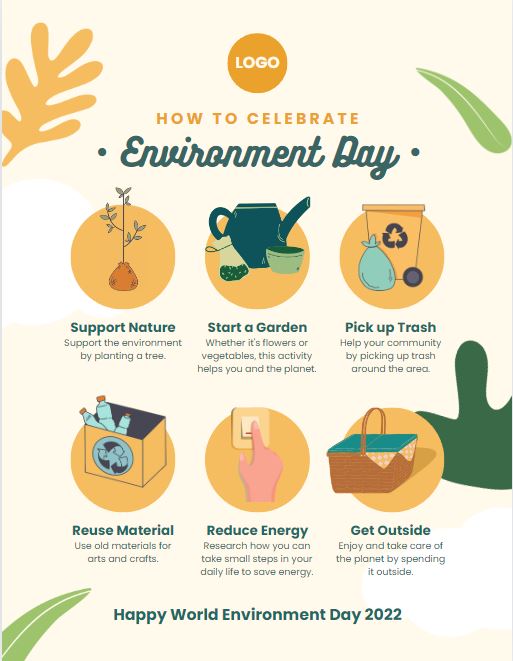 Getting Involved
Getting Involved
People can get involved in World Environment Day by:
- Participating in local events: Join clean-up drives, tree planting, or educational workshops.
- Spreading awareness: Use social media to share information about environmental issues and advocate for change.
- Making lifestyle changes: Adopt more sustainable practices such as reducing plastic use, conserving water, and minimizing carbon footprints.
World Environment Day continues to be a vital platform for fostering environmental stewardship and encouraging global cooperation in the fight for a healthier planet.
Share this:
- Click to share on Facebook (Opens in new window) Facebook
- Click to share on X (Opens in new window) X
- Click to share on LinkedIn (Opens in new window) LinkedIn
- Click to share on Pinterest (Opens in new window) Pinterest
- Click to share on Telegram (Opens in new window) Telegram
- Click to email a link to a friend (Opens in new window) Email
- More
How Laser Cutter Brings New Inspiration to the Classroom
STEM education–Science, technology, engineering, and math–sounds intimidating, but is actually one of the most satisfying learning experiences students can participate in. Makeblock (an Ask a Tech Teacher sponsor) has some excellent resources for this field. Today, we’ll discuss:
How Laser Cutter Brings New Inspiration to the Classroom
STEM education is the need of this modern era, which is why teachers look for some interesting ways to teach these subjects and skills. They try to find new activities, games, toys, tools, or anything that can engage students and help them learn without struggling.
A laser cutter can spark creativity among students. They can turn their imagination into reality, which gives them a sense of joy and pride. They can cut and engrave different types of materials and make products and items they like.
Students, as well as teachers, enjoy using a school laser cutter. It is a perfect option for K-12 schools, colleges, universities, DIY enthusiasts, artists, professionals, etc. It is completely safe and easy to use in schools and has the capability to turn learning into fun.
In this article, we will explain the benefits of using a laser cutter for education. We explore what students can make with the machine to uncover their creativity and develop various skills. Moreover, we will also share an ideal laser cutter for schools that empowers students to take their skills to the next level safely and easily. (more…)
Share this:
- Click to share on Facebook (Opens in new window) Facebook
- Click to share on X (Opens in new window) X
- Click to share on LinkedIn (Opens in new window) LinkedIn
- Click to share on Pinterest (Opens in new window) Pinterest
- Click to share on Telegram (Opens in new window) Telegram
- Click to email a link to a friend (Opens in new window) Email
- More
Earth Day Class Activities
Every year, the United Nations recognizes April 22nd as International Mother Earth Day. It is a day we can all participate in making our air clean, our water fresh and our land unlittered rather than accepting the trash-filled oceans, the smoggy skies, and the debris-laden land that is becoming the norm.
Despite the questionable health of our world, we have made progress. Back in 1970, when Earth Day was first celebrated, trucks spewed black smoke as they drove down the highways, toxic waste was dumped into oceans with no repercussions, and the general opinion was that the Earth took care of itself. That changed when U.S. Senator Gaylord Nelson, Earth Day’s founder, witnessed the ravages of the 1969 massive oil spill in Santa Barbara California and decided it was time to do something. He started with a “national teach-in on the environment” with a simple goal: Encourage people to recognize the importance of protecting the Earth:
“It was on that day [Earth Day] that Americans made it clear they understood and were deeply concerned over the deterioration of our environment and the mindless dissipation of our resources.”
Here are online resources (click for updates) to help you share the importance of Earth Day with your students:
- 25 Earth Day activities from WeAreTeachers
- Breathing earth– the environment
- Breathing Earth YouTube Video–of CO2 use, population changes, and more
- Conservation Game
- Earth Day Activities from Khan Academy
- Earth Day Activities from Science Buddies
- Earth Day Facts–video
- Earth Day Toolkit from NASA
- Ecotourism Simulation–for grades 4 and above
- The Four Seasons – An Earth Day Interactive Children’s Storybook (app)
- Green Kitchen (app)
- History of Earth Day
- My Garbology
- Starfall — Every Day is Earth Day
- Storyboard That! Earth Day lesson plans
How effective is Earth Day
Share this:
- Click to share on Facebook (Opens in new window) Facebook
- Click to share on X (Opens in new window) X
- Click to share on LinkedIn (Opens in new window) LinkedIn
- Click to share on Pinterest (Opens in new window) Pinterest
- Click to share on Telegram (Opens in new window) Telegram
- Click to email a link to a friend (Opens in new window) Email
- More
Invention Convention 2024 is coming
Invention Convention Worldwide is a global K-12 invention education curricular program mapped to national and state educational standards that teaches students problem-identification, problem-solving, entrepreneurship and creativity skills and builds confidence in invention, innovation and entrepreneurship for life. Signups for the annual Raytheon Technologies Invention Convention US Nationals start March 29, 2024 (that’s today–publication day for this article).
RTX Invention Convention U.S. Nationals 2024 will be held at The Henry Ford in Dearborn, MI on June 5-7, 2024. Here’s a calendar of events (from Invention Convention Worldwide):
Share this:
- Click to share on Facebook (Opens in new window) Facebook
- Click to share on X (Opens in new window) X
- Click to share on LinkedIn (Opens in new window) LinkedIn
- Click to share on Pinterest (Opens in new window) Pinterest
- Click to share on Telegram (Opens in new window) Telegram
- Click to email a link to a friend (Opens in new window) Email
- More
Engineers Week Feb. 18-24
This week, February 18-24, 2024, is DiscoverE’s Engineers Week. Their tagline:
“A week-long event, a year-long commitment”
Do you wonder why anyone would be passionate about engineering? Forbes published three good reasons:
- The U.S. has approximately 1.6 million engineering jobs that pay $42 per hour in median.
- Job growth from 2010 to 2014 was in the double digits in several engineering occupations.
- Since 2007, the number of engineering grads nationwide has shot up 33%.
Overall, engineering offers a combination of intellectual challenge, real-world impact, and opportunities for personal and professional growth. By pursuing a career in engineering, students can contribute to meaningful projects, solve complex problems, and make a positive difference in the world.
What is Engineers Week?
Engineers Week, also known as EWeek, is an annual event celebrated in the United States typically during the third or fourth week of February, this week: February 18-24, 2024 dedicated to promoting awareness and appreciation of engineering.
During Engineers Week, engineering societies, universities, companies, and other organizations organize workshops, competitions, seminars, outreach programs to schools, career fairs, and networking events. The goal is to inspire the next generation of engineers, showcase the importance of engineering in solving global challenges, and recognize the achievements of engineers and encourage young people to pursue careers in STEM (science, technology, engineering, and mathematics).
Share this:
- Click to share on Facebook (Opens in new window) Facebook
- Click to share on X (Opens in new window) X
- Click to share on LinkedIn (Opens in new window) LinkedIn
- Click to share on Pinterest (Opens in new window) Pinterest
- Click to share on Telegram (Opens in new window) Telegram
- Click to email a link to a friend (Opens in new window) Email
- More
13 Websites to Learn Everything About Landforms
If your third grader has to write a report about landforms, try these websites:
- Continents explained (with humor)
- Explore the Colorado
- Geography Games
- Geography Quiz Game
- Geologic movies–great and fun
- Landforms—matching games, etc.
- Mapping Game
- Rainforest life—people, etc.
- Rainforest tree house—virtual game
- Rainforest—Enchanted Learning
- Rainforests
- The Colorado River
- Virtual tour–undersea
If any of these website links don’t work, please click here for an update. (more…)
Share this:
- Click to share on Facebook (Opens in new window) Facebook
- Click to share on X (Opens in new window) X
- Click to share on LinkedIn (Opens in new window) LinkedIn
- Click to share on Pinterest (Opens in new window) Pinterest
- Click to share on Telegram (Opens in new window) Telegram
- Click to email a link to a friend (Opens in new window) Email
- More

